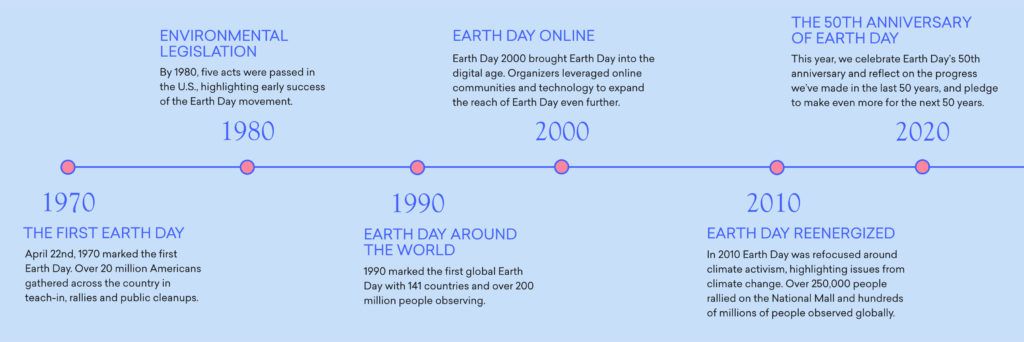Earth Day Through The Decades

April 8, 2020
4/8/2020
Written by: Natalie Henderson, Marketing @blueland
The first Earth Day was celebrated on April 22nd 1970, and has been celebrated every year since! What started as a teach-in to bring awareness to environmental problems, which at the time were centered on air, water and land pollution, has turned into a global holiday spurring action and activism around the world.
Each year, Earth Day is celebrated by hundreds of millions of people around the world. It started with just 20 million Americans, so how did we get here? Let’s take a look back at the last 50 years of Earth Day and the actions it has helped inspire.

The 1970s: The First Earth Day
The first Earth Day surprised organizers when over 10% of the American population participated. Cities across the U.S. hosted teach-ins, rallies and cleanups of public spaces. Environmental advocates brought attention to pollution of water, air and land and garnered support from the American public to combat pollution. Organizers and activists capitalized on the momentum and used it to incite government action. By the end of 1970, President Richard Nixon established the Environmental Protection Agency (EPA), the first government agency in the United States created with the specific goal of handling environmental issues.
The success didn’t stop there. Throughout the 1970’s, momentum from the environmental movement continued to grow and environmental legislation was passed.

Earth Day, Union Square
1980: Earth Day And Environmental Legislation
By Earth Day in 1980, there were significant environmental legislative achievements. Just 10 years after the first Earth Day, government protections over the environment drastically increased. By 1980, the following U.S. governments acts were passed:
• Clean Air Act (Expanded 1970): Set national standards for air quality and regulations for big industrial companies, aimed to reduce air pollution
• Clean Water Act (19720: Set national guidelines for wastewater and funded sewage and waste treatment plants
• Endangered Species Act (1973): Established an endangered species list, and banned sale, transport, and possession of any species on that list
• Safe Drinking Water Act (1974): Set standards for the quality of drinking water for all public water systems in the U.S.
• Resource Conservation and Recovery Act (1976): Allowed the EPA to be in charge of all hazardous waste, including recovery and storage.
These five acts signaled a commitment from the U.S. government to take the environment seriously.
Through the 1980’s, environmental advocates started to change their focus. While the original Earth Day was focused mainly on pollution, by 1990 Earth Day organizers and environmental advocates were focused on climate change. In 1985, scientists discovered significant depletion in the ozone layer, often described as a “hole” in the ozone layer. This discovery brought climate change to the forefront of environmental discussions around the world. By the time the 20th anniversary of Earth Day approached, the Montreal Protocol (1987) had been signed by all UN member states, and there was a global commitment to phase out chlorofluorocarbons and protect the ozone.
The 1990’s: Earth Day Goes Global
The 20th anniversary of Earth Day took the celebrations global for the first time. According to the Earth Day Network, 141 countries and over 200 million people observed Earth Day in 1990. The Earth Day Network is the primary organizing and coordination organization for Earth Day events around the world. There were outdoor rallies, concerts and hikes, all in celebration of the planet and to increase awareness for climate change.
Following the 1990 Earth Day, the UN held an Earth Summit in Rio de Janeiro, Brazil. The “Rio Declarations” laid out 15 principles recognizing the impact of human activities on sustainability and committing to sustainability goals. Seven years later, the UN Kyoto Protocol was signed setting commitments to reduce greenhouse gas emissions worldwide. The Kyoto Protocol committed signatories to greenhouse gas emission reduction, as well as established the connection between human activities and climate change.
The 2000’s: Earth Day In The Digital Age
Earth Day 2000 brought Earth Day into the digital age. Organizers leveraged online communities and technology to expand the reach of Earth Day even further. Earth Day organizers used the internet to organize events and increase reach and participation. Over 180 countries participated in Earth Day 2000, encouraging global conversations about the environment and climate change. This Earth Day was focused on energy, and its impact on the environment.
Following the 2000 Earth Day, the UN held the World Summit on Sustainable Development in 2002, building on the Earth Summit from 1992. Throughout the 2000’s additional countries signed the Kyoto Protocol, making the fight against climate change a global mission.
The 2010’s: Earth Day Activism
In 2010, the Earth Day Network re-positioned Earth Day as a movement for activism for the environment. Over 250,000 people participated in a rally on the National Mall and Washington D.C. and hundreds of millions of people observed Earth Day around the world. The Earth Day Network launched two initiatives in 2010, A Billion Acts of Green which encouraged Earth Day participants to climate focused actions or register their own acts of green and invite others to participate, and a tree-planting project. In addition, environmental groups around the world held events, clean ups and demonstrations.

Climate activism momentum continued steadily through the 2010s. In 2015, the Paris Climate Agreement was drafted. The agreement went beyond the Kyoto Protocol, and set a goal of achieving global net-zero emissions by 2050. The emission reduction target is set so as to keep global temperatures from rising above 1.5 degrees Celsius above pre-industrial levels. Since the Paris Climate Agreement went into action in 2016, 189 parties have ratified it, each developing their own pathways toward meeting the net-zero emission goal.
Earth Day 2020
This year, we celebrate Earth Day’s 50th anniversary with Earth Day 2020. The Earth Day Network will fill the entire day with programming through EARTHRISE, a digital observation of Earth Day. Though Earth Day will be focused on online engagements, the motivations are the same. Earth Day 2020 serves not just as a celebration of the planet, but again, as a call to action to protect the planet. Over the last 50 years, Earth Day has made an impact on the modern environmental movement. Earth Day has raised awareness, incited action and created change. This year, the Earth Day Network and climate advocates around the world hope to build on the historical momentum of Earth Day and incite more action and positive change.


